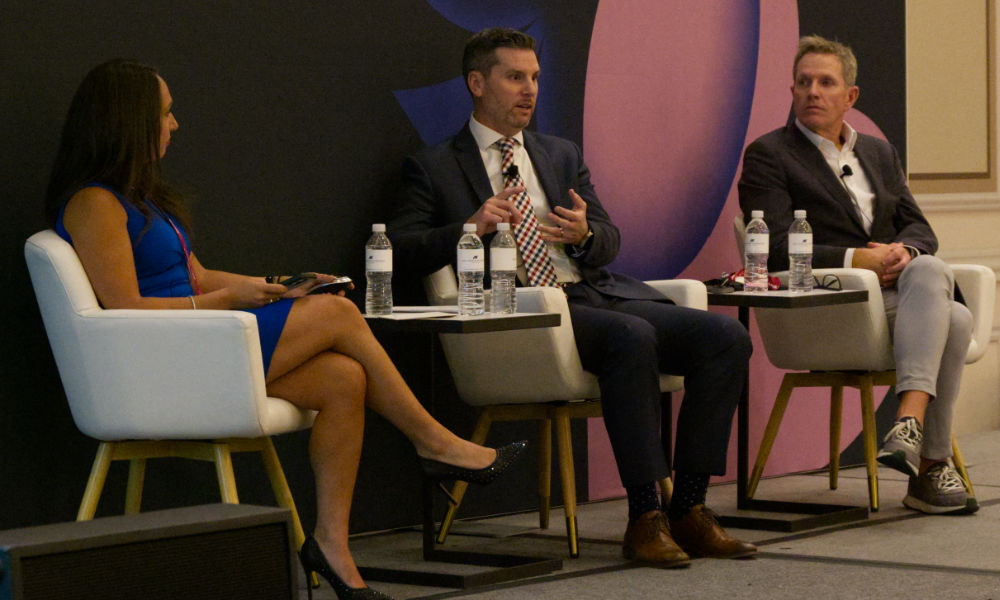Have you been confused about the tariffs in the news lately? Are you especially concerned about the impact they may have on our casino world? Well, rest assured, you’re not alone.
Nicole Porpoglia moderated a panel on the topic late Monday afternoon at the annual G2E conference. Her first question to the two gaming-industry panelists was to ask them to sum up the current tariff situation in just one word.
Ryan Comstock, COO at Ainsworth Game Technology, chose, “Uncertainty.”
Daron Dorsey, president and CEO of the Association of Gaming Equipment Manufacturers (the gaming-supplier industry’s trade association), followed with the word, “Disruptive.”
Porpoglia felt both words were appropriate. That was scary, since she’s a seasoned expert in such matters, serving as managing director at KPMG’s Trade and Customs practice in New York. She showed several informative slides, detailing the current tariff rates that varied from country to country and item to item. However, to complicate things even more, she noted that even many of the listed items were subject to instant change by President Trump or court rulings. And even that last hiccup could be up in the air, since most court decisions are generally put on hold until the appeal process is complete.
She added, “It’s important to note that these trade deals aren’t necessarily trade agreements established and released. Those are still in progress and we expect to see them in months or years to come. So what few details we have about these deals are very limited.”
Therefore, it’s easy to understand why Dorsey said, “This uncertainty makes it difficult to plan and come up with long-term strategies with our suppliers and customers, because we don’t know from day to day what’s going to change.”
Comstock noted that the industry has a lot to catch up on about tariffs. “Frankly, at a 1½% to 2.8% tariff rate, historically, we didn’t spend a lot of time managing, educating ourselves, or developing relationships with our service providers. It just wasn’t that much of a business risk. Now that we’re looking at 10%, 15%, 20%, as high as 30+% on the charts Nicole showed, there’s a massive kind of ramp-up period in the short term.”
While the updates on our country’s tariffs was depressing enough, Porpoglia showed an extensive chart of all the countries imposing reciprocal tariffs to counter the U.S. actions. These, too, are sure to add more disruption and add to the uncertainty.
Though the chart was difficult to read, it clearly showed that over five dozen countries will be imposing their own tit-for-tat tariffs on gaming products or gaming-related parts coming out of the U.S. All of these challenges will be complicated by the fact that the industry is heavily regulated.
Dorsey said, “From a manufacturer standpoint, the regulated nature of our industry makes it very difficult to react quickly. For example, if we want to switch monitor suppliers, we’re looking at electrical certifications from UL and GLI. You can’t just change power supplies, monitors, or other components in a week or two.”
The limited good news was that Porpoglia cited some tactics the manufacturers can explore to limit the damage. These ranged from using locally based Free Trade Zones (FTZ), which impose tariffs only once products are used, rather than when they’re imported. Another was noted by Comstock. “Rather than buying directly from an offshore supplier, we now look to buy from their U.S. distribution center.”
One other small plus was that manufacturers are now taking a much closer look at their trade practices. Using the ACE (Automated Commercial Environment) data provided electronically by the Customs and Border Protection agency, it’s easier to see exactly what impact individual components contribute to tariffs and what other options may be more efficient.
Porpoglia urged, “The Ddevil is in the detail of the data. This ACE information can be gold in understanding your impacts and allow you to brainstorm solutions.” She also urged the industry to push importers to monitor their data closely.
Comstock agreed. “The ACE data was eye opening. At the end of the day, we’re responsible.”
Too bad that he, along with everyone else, is still so uncertain about all the disruption.



